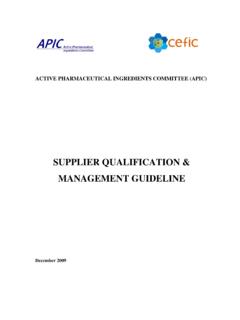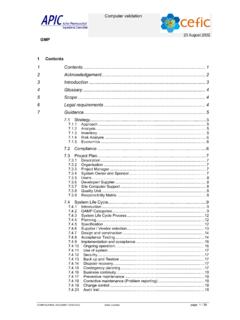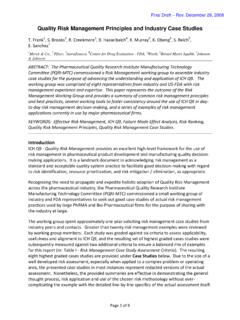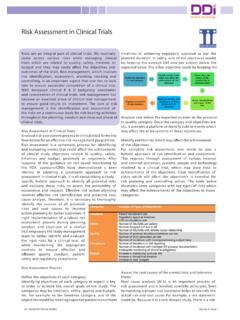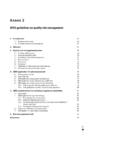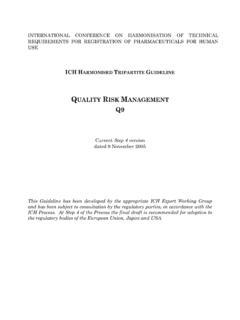Transcription of Additional guidance on the assessment on the risk ...
1 1/12 Active Pharmaceutical Ingredients Committee (APIC) Additional guidance on the assessment on the risk assessment for presence of N-nitrosamines in APIs 2/12 Table of contents 1. Introduction 2. Risk assessment guidance Prioritization of the risk assessment Management of raw materials in the risk assessment Risk assessment Content of risk assessment Boundaries of the risk assessment Methodology and outcome of the risk assessment Collaboration with customers Lifecycle of the risk assessment 3. Analytical Testing and Lifecycle Control Strategy Analytical Testing Control Strategy Lifecycle 4. References 5. Appendix 1 API Letter Report Template 3/12 Foreword This guidance document was prepared in 2020 by the APIC Nitrosamines Task Force on behalf of the Active Pharmaceutical Ingredient Committee (APIC) The Task Force members were.
2 Porras Gustavo Afaquim Valls Jordi Afaquim Garcia Jordi Afaquim Camps Helena Afaquim Dobarro Alicia Afaquim Van De Velde Stefaan Ajinomoto Bio-Pharma Services van der Ven Jos Aspen Oss Fransen Gerrie Aspen Oss Slangen Peter Jan Aspen Oss Fendt Rainer BASF SE Becker Christian BASF SE Hudecek Torsten Boehringer Ingelheim Corporate Center GmbH Hertlein Martina Boehringer Ingelheim GmbH van der Hoeven Pieter Cefic Herrero Sanchez Carlos Centrient Pharmaceuticals Miller Beate DSM Nutritional Products Strachan Fraser DSM Nutritional Products AG Lopez Esperanza Esteve Quimica Corradin Mariangela (Fabbrica Italiana Sintetici )SpA Govoni Riccardo (Fabbrica Italiana Sintetici )SpA Paulo Luisa Hovione FarmaCiencia SA Lochner Susanne Janssen Pharmaceutica NV Van Gompel Jasques Janssen Pharmaceutica NV Lindsay Anita MacFarlan Smith Archer Nick MacFarlan Smith Matthew Gavin MacFarlan Smith Mohan Ganapathy Merck & Company (MSD) Reichert Ulrich Merck KGaA Jeker Mirko Merck KGaA Raimbault Sophie Minakem Dunkerque Production Magnone Chiara Olon Storey Anthony Pfizer Todd Rachel Pfizer Li nart Philippe Roquette Freres Jurca Sabina Sandoz Cuderman Petra Sandoz 4/12 Katzmayr Martin Sandoz International GmbH Girard St phanie SEQENS Joffraud Julie SEQENS Verone Grosso Camille Seqens Schweinberger Enno Siegfried AG Lloris Maria UQUIFA SA Merete Hagen Hilde Vistin Pharma AS Junek Richard Zentiva Group Kohoutova Denisa Zentiva Group 5/12 1.
3 Introduction The EMA and other Health authorities have published requirements (EMA/189634/2019 [1] and Health Canada Letter [3] for the API industry and the MAH for drug products to expand the scope of potential sources of nitrosamines beyond that of ICH M7 [2]. This requirement is based on the fact that, as the Industry and the authorities are gathering more information about the potential ingress / formation of such impurities in APIs, there is need to expand the evaluation of risk assessments that are needed to ensure APIs are fit for their intended use and do not pose a patient safety risk for such impurities. These requirements are new to the industry and as such APIC had devised this document to aid industry generating risk assessments as well as assistance on the level of information that is needed to be sent to the MAH for their overall drug product risk assessments.)
4 As indicated, this is a recent requirement for the Industry and authorities, and as such the level of knowledge and understanding on it may evolve with time. Therefore, in certain areas that need to be assessed detailed specific information is not practically possible to add to this guidance document, plus it may be amended with time as new information become available. 2. Risk assessment guidance The request from health authorities is to perform the assessment to all market products. Due to the large numbers of products involved, EMA document [1] suggests the use of a risk-based approach to prioritize the evaluations and later the confirmatory testing (if the risk evaluation would indicate that testing would be required). The factors suggested are daily dose taken, duration of treatment, therapeutic indication and number of patients treated.
5 However, this data is not always available at the API manufacturers side, who might use other criteria such as the ones suggested below to perform the requested risk evaluations. Prioritization of the risk assessment The following criteria might be used for prioritization ( > meaning higher priority than ) depending on the information available: - Higher daily dose taken - Long duration of treatment - therapeutic indication - Higher number of patients treated - Commercial APIs > APIs used for clinical trials - API manufactured in multipurpose equipment > dedicated equipment - API manufactured in multipurpose equipment exposed to nitrosating agents - API > Intermediate > RSM (for companies manufacturing the three categories) - APIs still manufactured > APIs no longer manufactured but still on the market - APIs sold to markets where risk assessment have already been requested by authorities > APIs sold to other markets - Knowledge of the likelihood of a risk based on the chemistry of the process (presence of amine, nitro functionalities, nitrosating agents)
6 Management of raw materials in the risk assessment The need and type of information to be obtained from suppliers depends on the type of material and on its use in the manufacturing process. Following factors are helpful to assess the impact of the raw materials on the risk to have nitrosamines in the API. 6/12 - Regulatory status of the raw material in the associated regulatory file (RSM, processing ) - Chemistry of the raw material such as: complex process use of nitrosating agents and amines type of solvents used ( recovered in house or by 3rd party) - Number and type of chemical steps between introduction of raw material and final API stages. The evaluation should take in consideration: if the raw material is used in early or late steps of the API synthesis If the next step(s) can purge the impurities or not, and if yes at which level the impurity can be purged type of chemical process(es) is involved and process conditions if the next step(s) can purge the impurities or not and if yes at which level if the raw material is used in later stages of the API synthesis and no further crystallization is performed The information from raw material suppliers can be also obtained through questionnaires, which cover chemical process and risk of contamination at the raw material supplier s facility.
7 The scope of the questionnaire can be very narrow and composed by just the 2 questions below to perform an efficient screening, or more complex covering all applicable potential sources of nitrosamines as described in EMA [1]. The first option does not prevent from receiving later the results of the full evaluation to confirm the conclusions achieved. If required the API risk evaluation should be revised. - Do you manufacture nitrosamines, amines or sources of amines in the same equipment as those used to manufacture the raw material? - Do you use or is there a potential presence of nitrosating agents and/or amines (secondary or tertiary amines) in your manufacturing process? Examples of nitrosating agents can be found in EFPIA decision-tree for N-nitrosamine risk assessment [4] or IPEC questionnaire [5]. Information obtained from suppliers on the quality of water (especially nitrite and chloramines content) used in their process can be useful.
8 API manufacturers have observed that it is difficult to obtain feedback in due time as suppliers are learning on how to proceed. The API risk analysis should be clear on the depth of raw material information to be taken into account in the risk assessment . When the supplier s data is not available, possible actions are: - Quote this raw material as high risk in the API risk assessment due to the absence of response, which should be later confirmed either during the EMA process Step 2 [1] (confirmatory testing) or with the information received from supplier. The API risk assessment should be reviewed and updated as applicable. - Use scientific knowledge or literature to obtain information (synthesis pathway, etc.) - Use alternative source of information (website, audit ) Risk assessment EFPIA decision tree [4] is a helpful tool to undertake the risk assessment .
9 7/12 Content of the risk assessment The risk assessment should consider the following possible sources: - Raw materials: attention should be paid to recovered solvents, nitrosating agents, nitric acid, nitrites, dimethylformamide and/or other materials as per [1]. Some raw materials can be considered as low risk due to their chemical nature ( : heptane due to its polarity, ) Such low risk classification should be justified based on scientific literature. - Manufacturing process and reaction conditions: conditions forming or suppressing nitrosamines must be assessed such as temperature, pH, carbon treatment [6], chemical reduction [6] or excess of alcohol [7]. Purging factors, if known, can be useful to review the risk level [5]. - Structural study and potential subsequent degradation of the structural fragments: amine, The degradation pathway depends on the process.
10 - Water: Well-water and tap-water can contain nitrites and nitrates. Nitrite content is limited on a country by country basis. In EU the limits are typically between and ppm for well-water and tap water, as other global countries. If in house treatment ( addition of chloramines) is used the impact on the level of nitrosamines formation should be assessed. For APIs manufactured in countries outside Europe, specific analysis of the nitrite or nitrate content in water might be It is generally agreed that the level of nitrite in purified water is typically low, therefore purified water is considered as a low risk. In particular, steps of water carbon treatment are known to lower the nitrosamine content. On the contrary, ozonation of the water (containing traces of secondary amines) can theoretically lead to formation of nitrosamines.

